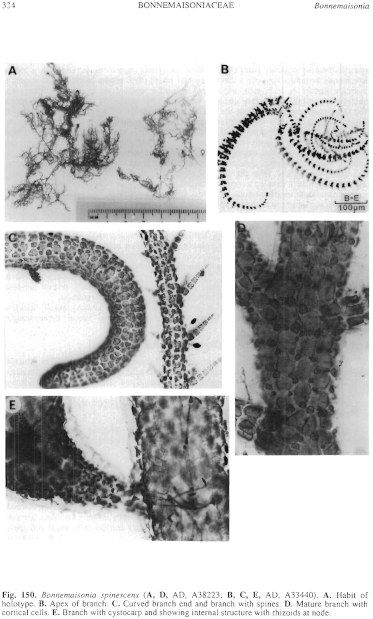|
|
|
|
|
|||||||||||
|
Electronic Flora of South Australia Species Fact Sheet
Phylum Rhodophyta – Class Florideophyceae – Order Bonnemaisoniales – Family Bonnemaisoniaceae
Thallus (Fig. 150A) medium red, 3–8 cm high, delicate, much branched and spreading, branching essentially distichous on irregular main branches, larger branches terete, 300–600 µm in diameter, usually bearing opposite branchlets alternately long and short (occasionally both of similar length or the short one absent); the longer branchlets 2–6 mm long, 80–120 µm in basal diameter and gently tapering, with two tiers of large cortical cells per axial cell and (4–) 5–6 (–9) -celled spines (Fig. 150C) 70–150 (–180) µm long on the first cortical cell from the periaxial cells and thus on alternating tiers; spines usually unilaterally arranged, occasionally opposite or in spirally situated pairs separated by 4–5 tiers; lower branchlets often with hamate ends (Fig. 150C). Short branchlets often becoming fertile or developing as longer branches. Attachment by a tuft of rhizoids or by hamate branchlets; probably epiphytic. Structure uniaxial (150B), with a small but prominent apical cell, the subapical cell cutting off two opposite periaxial cells which develop into branchlets; in branches, periaxial cells each cutting off 4–6 primary cortical cells which cover the axial cell (2–3 lengthwise, 6–8 around the branch), soon becoming subspherical and 35–50 µm across and cutting off small outer cells which form slight rosettes (Fig. 150D); inner cortex separated from the axial filament (Fig. 150E), with slender rhizoidal filaments bearing gland cells. Branchlets with 3 periaxial cells, each cutting off cortical cells to form two tiers per axial cell and 6 (–8) around the branchlet, cells rectangular in surface view and 15–35 µm across, L/D 1.5–2, with 2–3 small rounded cells cut off their upper ends. Rhodoplasts discoid, often in chains, numerous per cell.
Reproduction: Gametangial thalli dioecious, reproductive organs on the short branchlets. Carpogonial branches 3-celled, with a lateral tuft of nutritive filaments, on a stalk 5–7 axial cells long. Cystocarps (Fig. 151A) pedicellate, broadly ovoid, ostiolate, 400–500 µm in diameter, gonimoblast (Fig. 151B, C) much branched, arising from a basal fusion cell, with terminal ovoid carposporangia 20–35 µm in diameter; pericarp of numerous branched, erect, filaments with an outer cortical layer 1–2 cells thick. Spermatangial organs (Fig. 151D) with a firm mucilaginous sheath, shortly pedicellate, ovoid, (300–) 400–700 µm long and 300–500 µm in diameter, with a row of 5–8 axial cells each cutting off radially elongate periaxial cells branched 3–4 times, with an outer layer of 1–2 short cells producing radially elongate initials cutting off elongate-ovoid spermatangia.
Tetrasporophyte unknown.
Holotype from Investigator Strait, S. Aust., 33 m deep (Watson, 24.i.1971); in AD, A38223.
Distribution: Known from Investigator Strait, S. Aust., 41 m deep (Watson, 14.i.1971; AD, A38166), 31 m deep (Watson, 23.i.1971; AD, A41104), and 33 m deep (Watson, 24.i.1971; AD, A41061). Off Troubridge Light (Edithburg), S. Aust., 17 m deep (Shepherd, 4.ii.1969; AD, A33440). 6–8 km off Outer Harbor, S. Aust., 16 m deep (Loan, 9.viii.1963; AD, A26653). Off Cape Jervis, S. Aust., 10–12 m deep (Shepherd, 29.xi.1983; AD, A54607).
Taxonomic notes: Bonnemaisonia spinescens is a deep-water species, typical of the genus in its reproduction and structure, but differing from other species in having spines on the branchlets which have relatively sparse outer cortical cells and rectangular larger (inner) cortical cells.
References: The Marine Benthic Flora of Southern Australia Part IIIB
Publication:
Womersley, H.B.S. (28 June, 1996)
The Marine Benthic Flora of Southern Australia
Rhodophyta. Part IIIB. Gracilarialse, Rhodymeniales, Corallinales and Bonnemaisoniales
Reproduced with permission from The Marine Benthic Flora of Southern Australia Part IIIB 1996, by H.B.S. Womersley. Australian Biological Resources Study, Canberra. Copyright Commonwealth of Australia.
Illustrations in Womersley Part IIIA, 1996: FIGS 150, 151.

Figure 150 enlarge
Fig. 150. Bonnemaisonia spinescens (A, D, AD, A38223; B, C, E, AD, A33440). A. Habit of holotype. B. Apex of branch. C. Curved branch end and branch with spines. D. Mature branch with cortical cells. E. Branch with cystocarp and showing internal structure with rhizoids at node.

Figure 151 enlarge
Fig. 151. Bonnemaisonia spinescens (A, AD, A33440; B, AD, A38166; C, D, AD, A38223). A. Branch with cystocarp. B. Cystocarp with carposporophyte and discharged carposporangia. C. Carposporophyte with basal fusion cell. D. Mature spermatangial organs.

|
Email Contact: State Herbarium of South Australia |

|